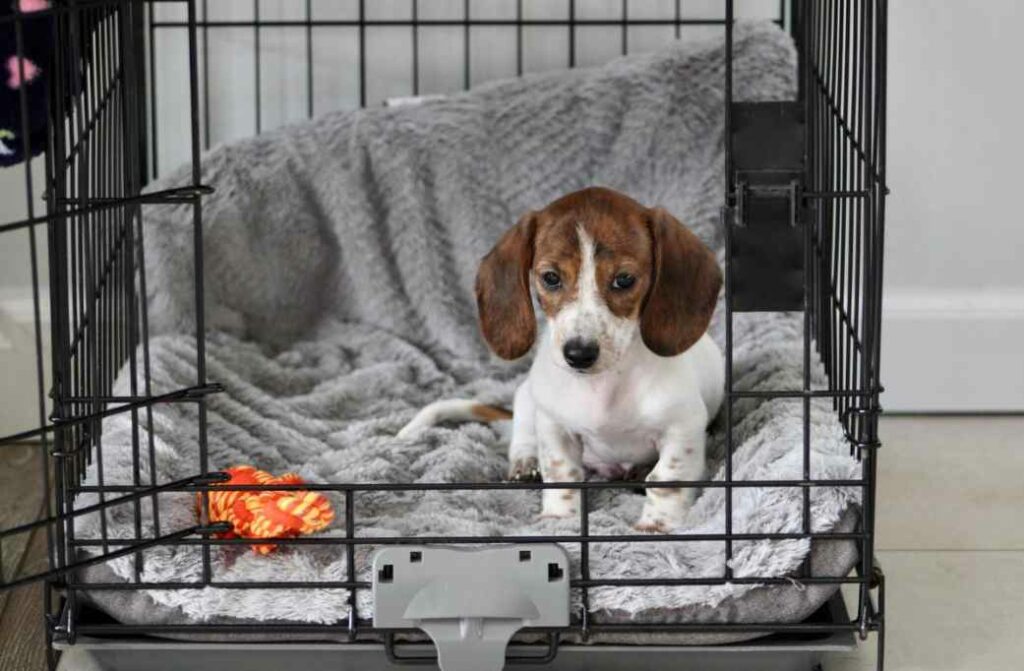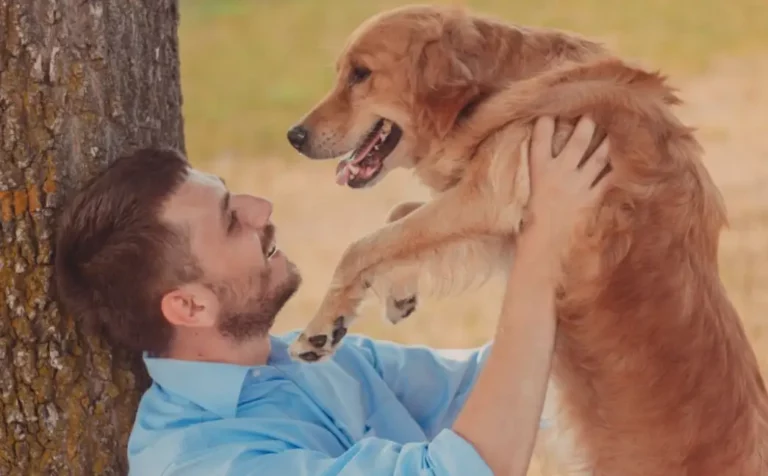Dog Crate Training – How to train your puppy quickly?
Crate training can significantly reduce separation anxiety in dogs by up to 73%, according to a 2021 study by veterinary behaviorists at Purdue University. This method creates a den-like environment for your canine companion, satisfying their instincts as den animals.
By providing Fido with his own special 42″ x 28″ x 31″ plastic airline-approved crate, you can minimize his stress during your 9-5 workday. The enclosed space gives him a sense of security in your absence and prevents destructive behaviors like chewing on your new $2,000 sofa or scratching the hardwood floors that cost $6 per square foot to install.

With proper crate training, your furry friend will happily spend up to 8 hours relaxing in his crate, surrounded by his favorite toys and blankets. He’ll associate the crate with treats and praise, making it a haven. You’ll come home to a calm dog and an undamaged home – a win-win for both owner and pet! Just be sure to give your pooch plenty of exercise and potty breaks before and after crating. Proper crate training takes 4-6 weeks of consistent, positive reinforcement.
Table of Contents
- When to use a dog crate?
- When not to use crates for dogs
- Selecting the right crate for your dog
- Making crate training a positive process for your dog
- Considerations around crating dogs during the workday
- Is it inhumane to crate a dog while at work?
- Tips to determining and stop confining your dog to a crate
- The key benefits of crate training your dog
- Conclusion
When to use a dog crate?
Most dogs naturally seek out a small, cozy area to relax, such as their oval-shaped 40″ x 25″ orthopedic dog bed or a corner of the living room behind the sofa.
A crate or kennel provides this safe space for up to 16 hours a day as their napping or sleeping area. It can also be a designated spot where they eat their twice-daily meals.
Leave your crate open with the door removed during the day so your dog can voluntarily retreat to it when they need peace.
Crates are also helpful when you simply can’t directly supervise your canine companion for short periods. Perhaps you’re busy preparing dinner, or young children ages 5-10 are coming over to visit. Their secure crate space protects your dog from getting into mischief, safeguards your belongings like shoes and books from damage, and shields your guests from jumping and nipping.
When your dog is overly excited, such as during the doorbell ringing or when you arrive home, crate training can quickly calm and control your pet. Use the crate positively for 5-10 minute timeouts, not as a punishment.
Puppies under 6 months old can also be excessively rambunctious with older dogs, so placing the pup in a crate is a smart temporary move to allow the older dog some peace.
As your dog starts viewing their crate as a comfortable den, it can also be utilized in-house training new 8-12 week puppies. Your young pup will begin to hold their bathroom needs for 2-3 hours when crated, as no one likes to urinate or defecate where they sleep. Puppies will learn it’s time to relieve themselves outside when let out of the crate.
If you can’t actively watch your unhousetrained puppy during the workday or overnight, the crate is an ideal place to leave until you can take them outside every 4 hours.
Lastly, crates are highly suitable for traveling in the car with your dog for 6-8 hours. Placing your unrestrained canine in a securely fastened crate is the safest method for your puppy to travel, offering a familiar space while protecting both dog and owner from any accidents or injuries that can occur.
The crate will also provide your dog with a safe, comfortable zone when they arrive in a new, unfamiliar place like a hotel or relative’s home.
When not to use crates for dogs
While crate training can be positive for owners and dogs when appropriately done, crates should never be used punitively. Locking a dog in a crate for over 2 hours as punishment can cause them to develop negative associations, leading to crate aversion.
If your dog shows signs of anxiety about the crate, such as flattened ears, tucked tail, visible trembling, or whining, it is inhumane to force them inside. A dog should willingly enter their open crate and see it as a safe space.
When left alone, dogs with diagnosed separation anxiety may panic and injure themselves trying to escape a crate. Their stress hormones like cortisol can spike to dangerous levels if crated when anxious.
Avoid crating your dog for longer than they can comfortably hold their bladder and bowels, especially puppies under 6 months old who need potty breaks every 2-3 hours. Soiling the crate can cause emotional distress.
Senior dogs over age 10 or those with arthritis should not spend more than 2-3 hours in a crate, as restricted movement can worsen joint stiffness and pain.
If a previously housebroken dog suddenly begins soiling their crate regularly, have your vet evaluate it for potential medical issues like urinary tract infections before continuing crating.
Never crate a sick dog vomiting or having seizures, as limiting their movement could be detrimental.
Avoid using crates to keep dogs quiet for your convenience. Dogs require daily exercise and stimulation. Proper crate use should never exceed 8-10 hours for an adult dog.
Do not crate dogs unattended in very hot or cold temperatures. They cannot access warmer or cooler spots when confined and are at risk for heat stroke or hypothermia.
In summary, while crating can benefit dogs correctly, improper or overly restrictive crate use can be inhumane and dangerous. Know your dog’s limits.
Selecting the right crate for your dog

The ideal crate should be durable, comfortable, and suited to your needs. Kennels made of thick plastic or galvanized steel mesh are suitable for outdoor use or dogs who prefer darkness, while airline-approved crates with metal or plastic shells excel for travel. Wire crates allow visibility and airflow for anxious dogs in warm climates.
If escape-proof, scanning off an area with a 42-inch tall pen or baby gates can also work for home crating. Avoid makeshift barricades that could topple your dog.
For durability, impact-resistant plastic and steel crates are best. If frequently moving, opt for a lightweight, collapsible fabric crate under 30 lbs yet sturdy enough for your dog’s size.
When buying, choose a crate that allows enough room for your dog to stand fully, turn around freely, and lie down stretched out. Measure your dog in a natural standing position from the tip of the nose to the base of the tail for proper sizing. For growing puppies, use an adjustable crate with a divider.
The crate area should be small enough to discourage pottying yet not restrictive. Place crates away from high-traffic areas where your dog feels comfortable and secure.
Inside, provide a washable, plush crate mat or towel for padding. You can also include safe chew toys for distraction and security blankets for anxious dogs. Always remove collars before crating to prevent injury from catching on the crate.
With proper selection and setup, an appropriately sized crate in the right location can become your dog’s happy haven for peace, privacy, and protection.
Making crate training a positive process for your dog
Making the crate training process favorable lets dogs explore and acclimate at their own pace. Introduce the open crate early, placing favorite toys and treats inside so your dog associates them with good things.
Keep initial crating periods brief – start with 5-10 minutes and gradually build up to a few hours as your dog adjusts. Adult dogs can handle being crated for up to 8 hours.
Make crating part of your dog’s routine with set mealtimes and potty breaks before and after. Feed meals in the crate to create a positive experience.
Use food puzzles like frozen Kongs to keep your dog happily occupied inside the crate for extended periods. This prevents boredom and anxiety.
Never use the crate for punishment or force your dog inside if they are fearful. Be patient and encourage them calmly with praise and rewards.
Keep arrivals/departures low-key when crating to avoid increasing separation anxiety. Ignore minor whining, but don’t release the dog if they escalate. The crate should be a safe den, not a prison. Start slow and make it enjoyable. With time and consistency, your dog will see their crate as their unique retreat.
Considerations around crating dogs during the workday
While crating can provide dogs security and prevent home damage, it requires caution and consideration of the dog’s needs.
- Adult dogs should not be crated for 8-10 hours to avoid accidents and distress. Puppies require let-outs every 2-3 hours.
- The crate should allow room for standing, turning, and lying down comfortably – too much space can encourage accidents. Proper sizing is key.
- Puppies under 6 months may not have complete bladder control and should not be crated for long workdays. Alternative arrangements should be made.
- Boredom and lack of stimulation during lengthy crating can lead to behavioral issues like separation anxiety. Enrichment toys are essential.
- Consider hiring a mid-day dog walker or pet sitter to let your dog out if you work long hours and cannot go home during the day.
- Doggy daycare can provide dogs with socialization and exercise on workdays, but it is costly and risks disease exposure. Do your research to find a reputable provider.
- If your schedule prohibits proper crating conditions, consider alternative arrangements like pet-friendly workplaces, dog walkers, dog sitters, or daycare.
While crating can be appropriate for adult dogs in moderation, puppies and long work hours pose challenges. When considering crating during workdays, consider your dog’s needs, limitations, and age. Their well-being should be the top priority.
Is it inhumane to crate a dog while at work?
There are reasonable arguments on whether crating a dog for long work hours is cruel.

Some key considerations:
- Adult dogs can typically tolerate crating for 8-10 hours, provided they get adequate exercise, socialization, and attention before and after. This may be acceptable in moderation.
- However, crating excessively can cause boredom, anxiety, and distress. Puppies and dogs prone to separation anxiety may be especially vulnerable.
- Mitigation measures like hiring a midday dog walker, providing enrichment toys in the crate, and gradually acclimating the dog to longer crating can help. But this may still be insufficient for some dogs.
- Monitoring your dog via pet cam can alert you to signs of distress like barking, whining, destruction, or elimination. But it doesn’t eliminate the distress or solve underlying issues.
- For dogs with separation anxiety or puppies, crating during full workdays may be inadvisable without other arrangements. Consider daycare, pet sitters, dog walkers, or dog-friendly workplaces.
- Ultimately, the dog’s welfare should come first. Continuing the practice without adjustments is likely unethical if they cannot tolerate lengthy crating. Their psychological health is paramount.
- Have an open and honest discussion with your veterinarian about what is best for your dog and their needs. Be willing to make changes to support their well-being.
While opinions differ, prioritizing your dog’s comfort and safety should drive the crating decision. Their needs must come before convenience.
Is it bad to crate my dog in another room at night? Expert Advice
www.puppiesdiary.com
Tips to determining and stop confining your dog to a crate
- The crate should always be available as a voluntary safe space for your dog, even after formal crate training ends. But forced crating can be phased out over time.
- Signs your adult dog is ready for complete house freedom: No destruction when left loose, no potty accidents, and no anxiety when alone loose in the home. Confinement is no longer needed.
- For puppies, waiting until 6 months is a good guideline before leaving loose for short periods. But continue crating when you can’t supervise until fully housetrained and less destructive, usually around 12-18 months.
- When beginning to discontinue enforced crating, start with short intervals of 15-30 minutes alone loose in the home while you’re still there. Gradually build up to longer periods over weeks/months as your dog proves trustworthy.
- Even if your dog seems ready for complete freedom, ease them into it slowly. Try loose time in one room before giving access to the entire house.
- If any accidents, destructive behavior, or separation anxiety occur when left loose, return to confining when you can’t supervise until your dog matures further. Take steps back as needed.
- Providing stimulating toys/chews and exercising your dog before time alone loose can prevent unwanted behaviors as you transition away from enforced crating.
The crate should always be available as your dog’s safe space. But only cease confining your dog when they have consistently proven capable of safety and good judgment when loose in your home alone.
The key benefits of crate training your dog
The key benefit of crate training your dog is it provides a safe den-like space that appeals to your dog’s instincts, giving them a place for rest and retreat. This can reduce dog anxiety.
Crates prevent destructive behaviors like chewing, digging, urinating, etc., when you can’t supervise your dog directly. It protects your belongings and home.
Crate training assists in housetraining, as dogs don’t like to eliminate where they sleep. It teaches bladder and bowel control. Traveling is easier when your dog is comfortable settling in a crate during car rides and at destinations. Crates provide safety and security – your dog can’t get into harmful situations while crated when you’re away.
Dogs see their crate as a comfort zone. It gives them privacy and protection when they need some alone time. Crating your dog takes patience and proper technique, but the long-term benefits make it worthwhile. It leads to better manners and behavior.
While crating is not suitable for every dog, when done correctly, it can give your dog a safe space, promote good habits, and make training easier. A crate-trained dog is usually a happy, well-adjusted dog.
Conclusion
Crate training is not bad; it helps the puppy live safely inside the crate at night.
Use proper training methods to train your dog. Slowly, the dog will adjust to living in the crate without a problem.
Please do not always put your puppy inside inside the crate; it is inhumane. Let the dogs play outside, which will help reduce their aggression, stress, and anxiety.




![Can You Leave Newborn Puppies Alone With Their Mom? [Vet Advice] 7 Can You Leave Newborn Puppies Alone With Their Mom? [Vet Advice]](https://www.puppiesdiary.com/wp-content/uploads/2023/01/Can-You-Leave-Newborn-Puppies-Alone-With-Their-Mom.webp)

![Do Dogs Know When You Are Sick? [5 Amazing Facts] 9 Do Dogs Know When You Are Sick? [5 Amazing Facts]](https://www.puppiesdiary.com/wp-content/uploads/2023/04/Do-Dogs-Know-When-You-Are-Sick-768x558.webp)